1. CENTRAL/ WEST AFRICA
Demand from China and India drive log prices up
Demand from China and India has once again pushed prices for selective logs. West African
exporters reported that demand was high as arriving log ships had to wait for some days
before logs were available for loading.
SNBG raises okoume log prices
Gabon's SNBG has raised the prices of okoume logs for producers by 4%, which would soon
prompt a rise in export prices. Producers and exporters have for some time been lobbying
the SNBG to increase the fixed okoume and ozigo prices in line with the general advance in
prices for virtually all species over the past six months. However, producers continue to
complain that prices for lesser/secondary log species have remained too low. They argue
that log and transport costs are the same as for the primary species.
Market speculates on resumption of Liberia exports
In spite of the current high demand and rather steady and stable market conditions, some
exporters in the region were anxious over the eventual resumption of exports from Liberia.
Unconfirmed reports indicated that some potential buyers had been already in contact with
potential producers and that exports might resume before the end of the year. Liberian
niangon is certain to reclaim its niche as the favourite species for French buyers.
Although a quite substantial harvest volume of species is
said to be planned in Liberia, it is likely that the reactivation of logistics and
infrastructure will take some time before full production could be achieved.
Sawnwood prices hold firm despite holiday season
Sawn lumber prices remained stable in July. Most sawmills were working at full capacity
with existing contracts for sawn lumber and downstream products, but buyer's interest from
Europe for new contracts had diminished due to summer vacation. However, asking prices
were still very firm and most producers feel that demand will remain strong in spite of
the holiday season. Sawmills looked forward to the end of August when European buyers
would be back in the market to cover
for the autumn and winter stock.
Peeler veneer prices under pressure
Peeler veneer prices are still stagnant and under heavy competition in the European
market. So far this has had no impact on peeler log demand and prices. With China's rapid
growth in manufacturing and exports of plywood, producers are confident the peeler log
market will remain
steady.
FoE launches campaign to include maobi in CITES
Friends of the Earth France and Cameroon have launched a campaign to include maobi
(Baillonella toxisperma) in Appendix II of CITES. The campaign would explain the social
and ecological importance of moabi to French distributors of wood tropical. Maobiu, found
in the Congo Basin, is a hard grained pink timber with excellent weather resistance, used
in shipbuilding, external joinery
(windows, shutters, etc.), garden furniture, flooring, gates and front doors.
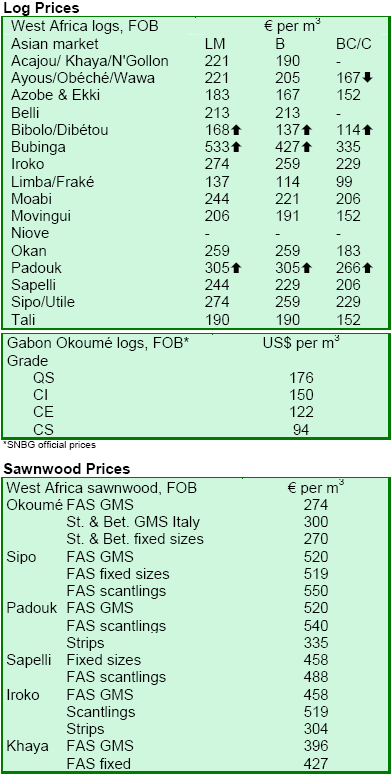
APP Timber to source West African timber
Malaysia's APP Timber, a worldwide supplier of sawnwood, veneer and wood products, has
opened a new branch office in Douala, Cameroon to source sawn timber from West Africa.
Dutch demand for African sawn timber is increasing due to the dwindling supply of sawn
timber from Indonesia and Malaysia. Substitute species such as sapele, bangkirai, azobe,
okan, bilinga and okoume are suitable for general carpentry, construction, decoration,
decking and flooring, among others. Sapele is an approved KOMO species already widely used
by door and window frame manufacturers.
APP Timber also plans to source species such as pachyloba, iroko, wenge and ovangkul which
are widely used for two and three layer engineered flooring.
2.
GHANA
Prices poised to surge after 10% fuel price hike
Prices for Ghana's timber products remained largely unchanged. However, it is anticipated
that the
government's recent 10% fuel price increase (the second in the year) might slightly drive
prices up.
DFID teams visits Ghana for VPA talks
A delegation from the UK Department for International Development (DFID) visited Ghana to
discuss the Voluntary Partnership Agreement (VPA) between the two countries, under which
Ghana would commit that laws governing the harvesting, felling and processing of timber
would be respected. Under the agreement, the government should ensure that operators in
the industry would not take more than what the law allowed from their respective
concessions. The delegation, headed by
Mr. Gareth Thomas, also observed the timber industry's operations during its visit.
Mr. Thomas said the EU would offer resources and technical advice to help the Ministry and
the Forestry Commission to institute measures to detect legal and illegal timber on the
market, adding that the UK, which already had a programme of financial assistance and
technical advice with the Forestry Commission, was ready to step increase this assistance.
Association calls for streamlining of operations
Accra's Timber Sellers Association (TSA) called for effective cooperation among forestry
personnel, sawnmillers and timber sellers to streamline the operations of the timber
industry in the country. TSA proposed that bush mill operators be attached to big
concession timber companies, to ensure proper supervision by officers of the Forestry
Commission. It added that such cooperation would ensure that only approved timber would be
felled.
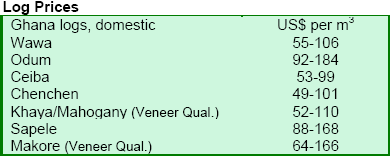
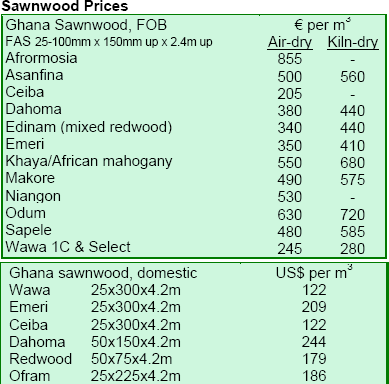
3. MALAYSIA
Profitability improves amid supply shortage worries
Malaysian timber exporters are finding themselves cornered again. While the recent 30%
price increase for most species across the board has improved profitability for most
timber companies, the supply situation remains extremely tight. Buyers are expected to pay
a premium for most timber species, especially meranti and merbau. However, timber traders
are apprehensive about marking up prices any further, as this may drive more buyers to
alternative suppliers in Indo-China. According to some analysts, apart from the shortage
situation, there were no strong fundamentals to drive the market up any further.
While the furniture and other timber processing industries laud the export ban on
finger-jointed rough sawn rubberwood and a plan to establish 375,000 ha of forest
plantations (see below), they regret facing the acute shortage of raw materials. Plywood
and panel products manufacturers are increasingly turning to bamboo and oil palm fibers as
alternative sources of materials.
Meanwhile, exorbitant freight charges have deterred most Malaysian timber merchants from
buying timber from Australia and New Zealand. In spite of their proximity, freight charges
from these countries are comparable to those in Europe or North America.
Apart from a handful of public-listed or well-funded companies, most Malaysian timber
companies are unable to compete with Chinese companies operating in Indo-China or European
companies operating in Africa, in sourcing for raw material supplies.
Malaysia dispatches plantation mission to L. America
The Minister of Plantation Industries and Commodities, Datuk Peter Chin Fah Kui, said its
ministry would organise missions to Mexico, Peru and Venezuela by the end of July to study
the modus operandi in managing forest plantations and rehabilitation of degraded forests.
The missions were under the 2.2 billion ringgit programme to establish 375,000 ha of
forest plantations over the next 15 years. Mr Chin said the timber industry must be
mindful of the various challenges and difficulties
ahead and must reconcile to the fact that the era of cheap and abundant timber resources
was over. He pointed out that for the long-term viability of the industry, there was a
need to develop forest plantations on a much bigger scale as the country could no longer
rely on timber from the natural forests to sustain the industry. He said that there must
be some synergy between the upstream and downstream sectors, particularly in the
distribution chain of raw material supply which was far from efficient.
Rubberwood can live without "Malaysian oak" tag
Datuk Peter Chin Fah Kui, Minister of Plantation Industries and Commodities, advised the
timber industry to refrain from promoting rubberwood as "Malaysian oak".
Recently, UK's Timber Research and Development Association expressed concern about the use
of the term which, it said, violated the UK Trading and Advertising standards and Trade
Description Act. Mr. Chin added that rubberwood furniture products would remain
competitive in the international market without the ¡¡ãoak¡¡À promotion.
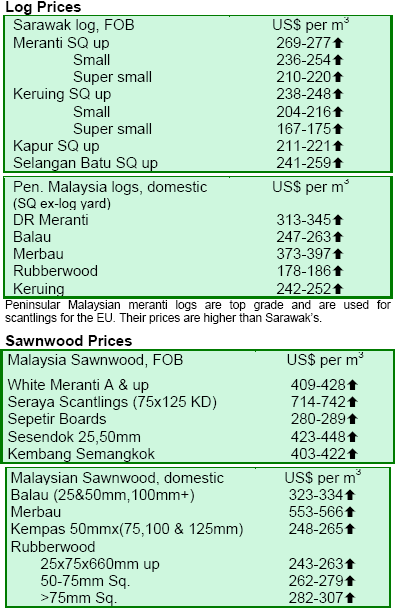
4. INDONESIA
Influx of illegal logs from slash-and-burn
activities
Opening burning in forest plantations and timber concessions continues to blaze across
Indonesia. The haze generated by the fires has drifted to Singapore, Malaysia and
Thailand. According to some traders, slash-and-burn activities have brought about a flood
of logs, especially illegally felled timber in the Indonesian domestic market, putting
down pressure on prices, particularly for sawnwood. According to these traders, it is
increasingly harder to differentiate timbers that are
legally harvested from those which are illegal in the market, since hardly any
documentation exists to track down the chain of custody.
Greater presence of Japanese and Korean traders
Apart from buyers from China and Europe, the market is witnessing an influx of traders
from South Korea and Japan as well. These traders, however, do provide a stabilising
factor to the market. Wary of the need to maintain a good corporate image in their home
country, a number of Japanese and Korean buyers insist on the legal origin of the
supplies.
China and Japan offset slow US demand
The hurricane season in the US has so far been tame and has not created the kind of demand
that plywood manufacturers were forecasting. However, plywood prices are holding firm,
thanks to demand picking up from Japan and China. Prices of most panel products remain
unchanged.
More on the Indonesian sawnwood ban
Information obtained from the Indonesian Ministry of Industry (DPRIN) and UK's
Environmental Investigation Agency (EIA) sheds further light on the Indonesian regulation
on sawnwood and other forest products of 2 February 2006 that supersedes the previous
regulation of October 2004. Under the new regulation:
1. Exports of railway sleepers (HS 4406) are forbidden.
2. Exports of sawnwood (HS 4407) are banned, with the following exceptions:
? surfaced four sides sawnwood (S4S), kiln or airdried and a
cross-section no greater than 4,000 mm2;
? door or window jambs S4S (including HS 4407) no more than
60mm thick and 150mm wide;
? door or window frames S4S (including HS 4407) no thicker
than 40mm and no wider than 200mm; and
? finger jointed S4S (including HS 4407) made of dried chip
wood no longer than 1,500mm.
3. Tolerance: all processed wood products must have 16% maximum moisture content (except
palette) and 5% maximum machine defect of export volume.
4. Only registered exporters, enlisted in the Exporter of Forestry Industrial Product
(ETPIK) are allowed to export forest products.
5. Endorsement from Forestry Industry Revitalization Agency (BRIK) is required for export
of HS products 4407, 4408, 4409, 4410, 4411, 4412, 4413, 4415, 4418, 4421.90.50.00,
9406.00.92.00, by processing the product export notification (PEB) document.
6. Any exception may only be decided by the Minister of Trade or the authorized department
after due consideration by the Departments of Forestry and Industry.
Double digit growth seen for furniture exports
Indonesia's furniture exports are expected to grow by 8-10% a year after 2005, Trade
Minister Mari Elka Pangestu said. Indonesia's furniture exports rose 12% to $1.96 billion
in 2005, with non-wood furniture performing better than wooden furniture, according to the
Minister. However, Indonesian furniture was facing strong competition from similar goods
made in Vietnam, China and the Philippines. According to Ms. Pangestu, Indonesia's main
competitors were Vietnam and China,while the Philippines and Malaysia competed with
different types and designs. She called on handicraft exporters not to rely on abundant
supply of raw material in improving product competitiveness but on design to meet buyers¡¯
demand. From the design, Ms. Pangestu said, producers could determine combination of raw
material that would be used. Apart from wood and rattan, there were many other kinds of
materials such as banana leaves and natural fiber that mixed with synthetic materials, she
said. Each market has a different taste and Europe would be the main target in the
development of design for local furniture products. She urged manufacturers to improve
image as Indonesian products still appeared as of low quality. While targeting to compete
with Vietnam and China in the middle-end market, Indonesia must increase its
competitiveness both
in raw materials, design and cost, she added.
Indonesia turns to imported logs for veneer slicing
Indonesia's imports of US hardwood products rose 10.6% to $41.5 million but declined 8% in
volume in 2005, due to price increases, according to Asian Timber. This consolidated
Indonesia as USA's largest hardwood market in Southeast Asia, behind Vietnam which was
catching up fast. As Indonesia¡¯s veneer slicing capacity turned to imported
logs, US imports met part of Indonesia's demand for furniture export and flooring markets.
Half of Indonesia's imports were accounted for
by logs, indicating Indonesia's commitment to promote processing of logs, mainly for
veneer and flooring.
Lumber imports from the USA rose 2.3% in value and 4.6% in volume indicating a slight
reduction in average prices. Red oak logs ($10.7 million) accounted for 25% of the total
imports, up 26% from 2005. Imports of white oak lumber were relatively stable, up 1% in
volume but down 5% in value reflecting slightly lower prices. Maple log imports climbed
36% to $3 million. Other significant
gains were seen in imports of birch veneer (up 500%), walnut logs (up 167% to $1.5
million) and cherry logs, lumber and veneer (worth $4 million).
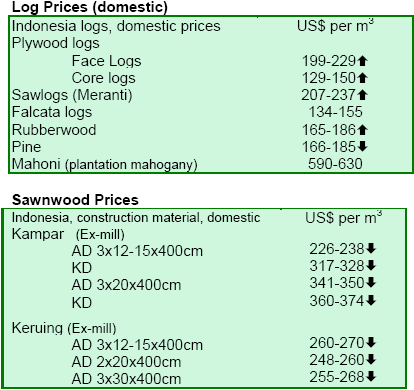
5.
MYANMAR
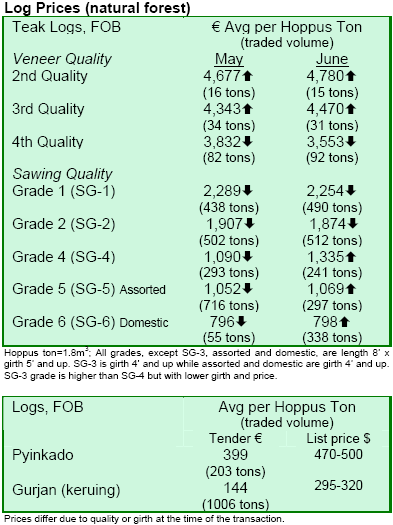
¡¡
6.
PAPUA NEW
GUINEA
Surge in PNG log exports in May
Log exports from PNG amounted to 237,095 m3 in May and declined to 194,930 m3 in June
2006. Total log exports (excluding plantation) amounted to 2,416,098 m3 in the year to
June 2006. Saw/veneer grades accounted for 84% of the total. Main log export species were
taun, malas, bintangor and terminalia. China took 79% of all log exports, followed by
Japan (8.1%), Vietnam (5.7%) and Korea (4%). Of the saw/veneer log grades, China imported
88%, Japan 5.8%, Korea 2.6% and Vietnam 1.1%. For plantation species, kamarere remained
the main export species primarily to the markets of Vietnam, Japan, China and Korea.
PNG slams ENGOs' allegations
PNG¡¯s Forest Minister Patrick Pruaitch has accused Greenpeace of denying PNG's
economic development by leading anti-logging campaigns in Europe. Mr. Pruaitch said
Greenpeace, WWF and other NGOs had been pressuring buyers in Europe and Australia not to
buy timber products from PNG. He said the forestry sector had contributed significantly to
the country's economic
growth, employing 10,000 people and contributing 5% to GDP and $176 million in annual
export earnings.
Mr. Pruaitch said the logging industry in PNG was operating legally, complying with all
forestry regulations. Mr. Pruaitch added that several reviews showed that most logging
operations were conducted legally and the National Forest Authority had been quick to stop
any illegal operation.
Eco-forestry not at commercial forestry's expense
Forest Minister Patrick Pruaitch informed that an ¡¡ãindependent review¡¡À of
the forest industry, required by the World Bank as part of a condition to a loan to
improve the forestry sector, was never completed because the World Bank imposed certain
conditions which the PNG Government did not agree with, and the loan was cancelled. The
review called for the promotion of eco- and subsistence forestry at the expense of
commercial forestry. He said that eco-forestry had its place and the government was not
opposed to it. However, substituting commercial forestry with eco-forestry would reduce
economic growth, eliminate jobs and affect infrastructure development in rural areas.
He said the allegations about illegal logging by Greenpeace were sourced from materials
used from the independent review, which had been dimmed baseless. Allegations that PNG was
destroying its environmental heritage were also false and deliberately alarmist, he added.
According to Mr.Pruaitch, 33% of forests in PNG had been designated for commercial use, 5%
reserved and 63% remained unallocated and non-productive. Mr.Pruaitch said most of the
unallocated areas were ¡'old growth' or 'primary' forests. He pledged that the
PNG government would resist any effort by ENGOs to weaken the PNG economy.
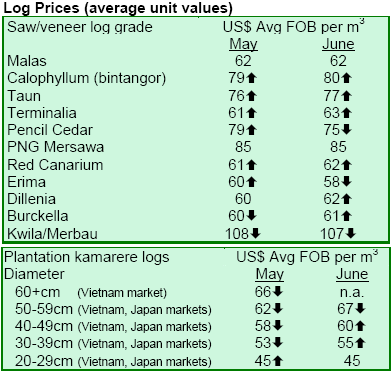
7. BRAZIL
Domestic prices gain as US dollar slumps again
Prices of wood products in Brazilian reais were largely unchanged in July. Conversely,
prices in US dollars rose 3.8% during the month due to the continued appreciation of the
Brazilian currency against the US dollar.
Food giants set to boycott illegal Amazon soy
Leading European supermarkets, food manufacturers and fast-food chains, including McDonald¡¯s, were expected to pledge not to use soy illegally grown in the Amazon in
response to evidence from Greenpeace that large areas of virgin forests were being felled
for the crop. The companies were expected not to source soy from four trading giants (US
Cargill, ADM and Bunge and
Brazilian firm Gruppo Maggi) who dominate production in Brazil unless they prove they are
not sourcing soy from areas farmed illegally.
Traders were expected to sign up to a moratorium on using soy grown in the Amazon.
Greenpeace traced the movement of soy from the Amazon through the USbased firms to chicken
factories in European countries. Greenpeace alleged that Amazon-grown soy was found to be
going into the supply chain of McDonald¡¯s, KFC, Tesco,
Sainsbury's, Asda, Morrisons and Unilever.
ABIMCI urges government to speed up regulations
The Brazilian Association of Mechanically Processed Timber (ABIMCI) has cited some factors
that have created an unfavourable scenario for the country¡¯s
solid-wood sector:
? Appreciation of Brazilian reais versus the US dollar and
euro, increasing raw materials cost.
? Delay in the definition of the regulation for sustainable
forest management (SFM) in the Amazon region.
? Competition from Chinese products in main international
markets.
After a period of strong adjustments in the sector, including reduction of
installed capacity and investment, lay-offs and redirection of products to other markets,
the growth of the Brazilian solid-wood sector stopped in 2005 and was expected to contract
in 2006. ABIMCI underlined the lack of definition of SFM operations in the Northern Amazon
states and of rules that stimulate the expansion of planted forests nationwide as the
major problems. ABIMCI argued that although the Ministry of Environment approved the
Public Forests Concession Law and promised to implement it this year, it had not offered
yet a transitional model to the forest sector, causing a partial paralysis of current and
future investments. ABIMCI said certain NGOs were pressuring the federal and regional
governments not to allow the expansion of forest plantations. ABIMCI urged the government
to promote the expansion of forest plantations to guarantee the supply of roundwood to the
solid-wood industry.
Strong real pushes furniture exports down
Brazilian exports of furniture decreased 11.3% to $451.9 million in the first semester of
the year. The decline was due to reduction in orders from the two main importers,the USA
and France, which accounted for 33% and 9% of the Brazilian exports, respectively.
Furniture exports to the USA fell 26% in volume and value to $149.2 million while those to
France dropped 19.4% to $41.5 million. However, a more drastic reduction was seen in
Germany (Brazil¡¯s fourth furniture market), which plunged
49.2% to $15 million. A main factor behind the decline of furniture exports is the
continued appreciation of the real. According to a study, the minimum exchange rate for
the furniture sector to operate should be at 2.50 real per US dollar as opposed to the
current 2.17 real.
Among the ten top export destinations, Argentina showed the best performance. However,
this country has made an inquiry on unclear sale practices by few wood Brazil cabinet
manufacturers. This was expected to be resolved.
Para exports boosted by value-added products In spite of the crisis faced by
the forest productive sector in Brazil, Para¡¯s value exports
of industrialized and manufactured wood products soared 21% in the first half of 2006.
However, its export volume decreased 2.6%. About 57% were higher value-added products.
Sawnwood accounted for 43.6% of the exports followed
by wood flooring with 38.1%. Nevertheless, the performance was sustained by raw material
stocks from previous harvest seasons. The situation would likely be reversed in the next
semester due to lack of replenishment of wood raw materials. Unfavourable exchange rates
and the non approval of SFM projects, would be the other factors affecting the exports of
timber
products in the second half of the year.
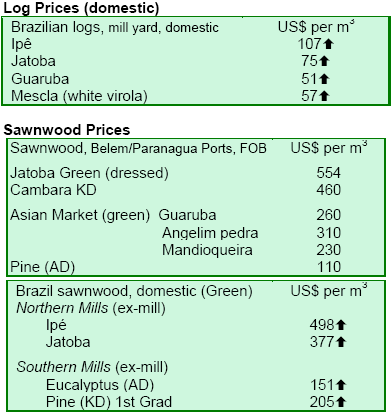
8.
PERU
In the interest of forest management transparency
INRENA, NGOs PROETICA and TRAFFIC and the Peruvian Society of Environmental Right signed
the ¡°Frame Inter-institutional Cooperation Agreement for the
Promotion of Transparency in the Forestry Sector¡±. The
agreement aims at promoting transparency in the management of forest resources in the
country. PROETICA will provide support through monitoring and
following-up activities in the different stages of the administrative processes.
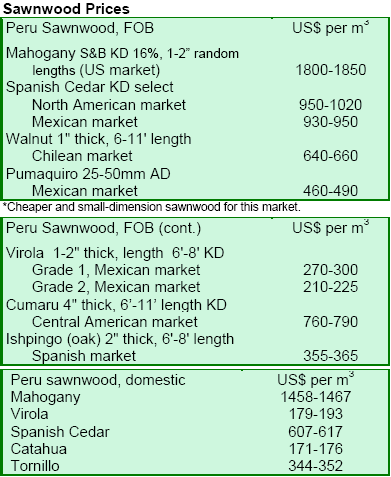
9. BOLIVIA
Bolivia lobbies for ATPDA extension
Bolivian Vice-president Alvaro Garcia Linera headed recently to Washington to urge the US
government to extend the Andean Trade Preference Act (ATPDA), which expires in December
2006. The USA is Bolivia¡¯s main market for lumber products,
importing $39.2 million (48% of Bolivia¡¯s total) in 2005.
Vice-president gives assurances to concessions
On a recent visit to the forest concession La Chonta,Bolivian Vice-president, Alvaro
Garcia Linera, observed sustainable forest management at work. He assured that there would
not be subjugation of forest rights and guaranteed the permanence of legal forest
concessions.He said that land re-distribution would be in fiscal forest areas not under
concession.
Bolivia celebrates 10th anniversary of Forest Law
Bolivia celebrated the tenth anniversary of the Forest Law on 12 July 2006. During the
celebration, the following achievements were highlighted: the democratization of the
access to the forest (forest concessions); almost 9 million ha under sustainable forest
management and forest regulation; the certification of more than 2 million ha of forests;
the establishment of the Forest Superintendence; growth in timber processing (80% of the
total exported); and the creation of more than 90,000 jobs.
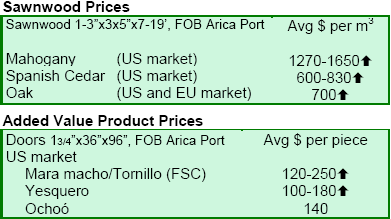
10. Guatemala
Free Trade Agreement USA - Guatemala starts
The Free Trade Agreement (FTA) between Guatemla and the USA started officially on 1 July
2006. Under the agreement, all Guatemalan forest products can be exported to USA without
import taxes. The tariffs on exports of US forest products to Guatemala will be gradually
eliminated: 8% of the total product will not be subjected to tax after five years while
64% (such as sawnwood and some other sensitive products) will not be taxed after 10 years.
Guatemala beefs up investment on teak plantations
From 1997 to date, the Guatemalan government has invested $1.77 million in teak plantation
projects. There were 6,823 ha planted in 335 projects. Plantation forests had been
expanding in Guatemala due to the Programa de Incentivos Forestales (PINFOR), an incentive
programme through which the state offers money to land owners during the first six years
of reforestation activities.

11. Guyana
Logs and sawnwood account for 70% of exports
Export of forest products from Guyana was just over $26 million at the end of June 2006.
Sawnwood and logs accounted for over 70% of the export value. Demand remains strong and
prices stable. However, purpleheart log prices continue to climb and are expected to reach
the $200 per m3 level in coming months as demand grows. Guyana continues to successfully
broaden the range of species and products exported. Bulletwood (macaranduba), tonka bean
(cumaru), greenheart, darina (angelim pedra) and mora are all now being exported for
various end uses including decking, flooring, profiled lumber and truck flooring. Stacking
sticks was also emerging as a good product for off cuts and a range of previously
underutilized hardwoods.
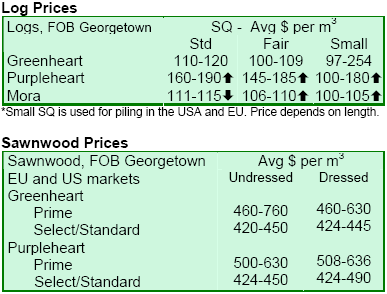
|